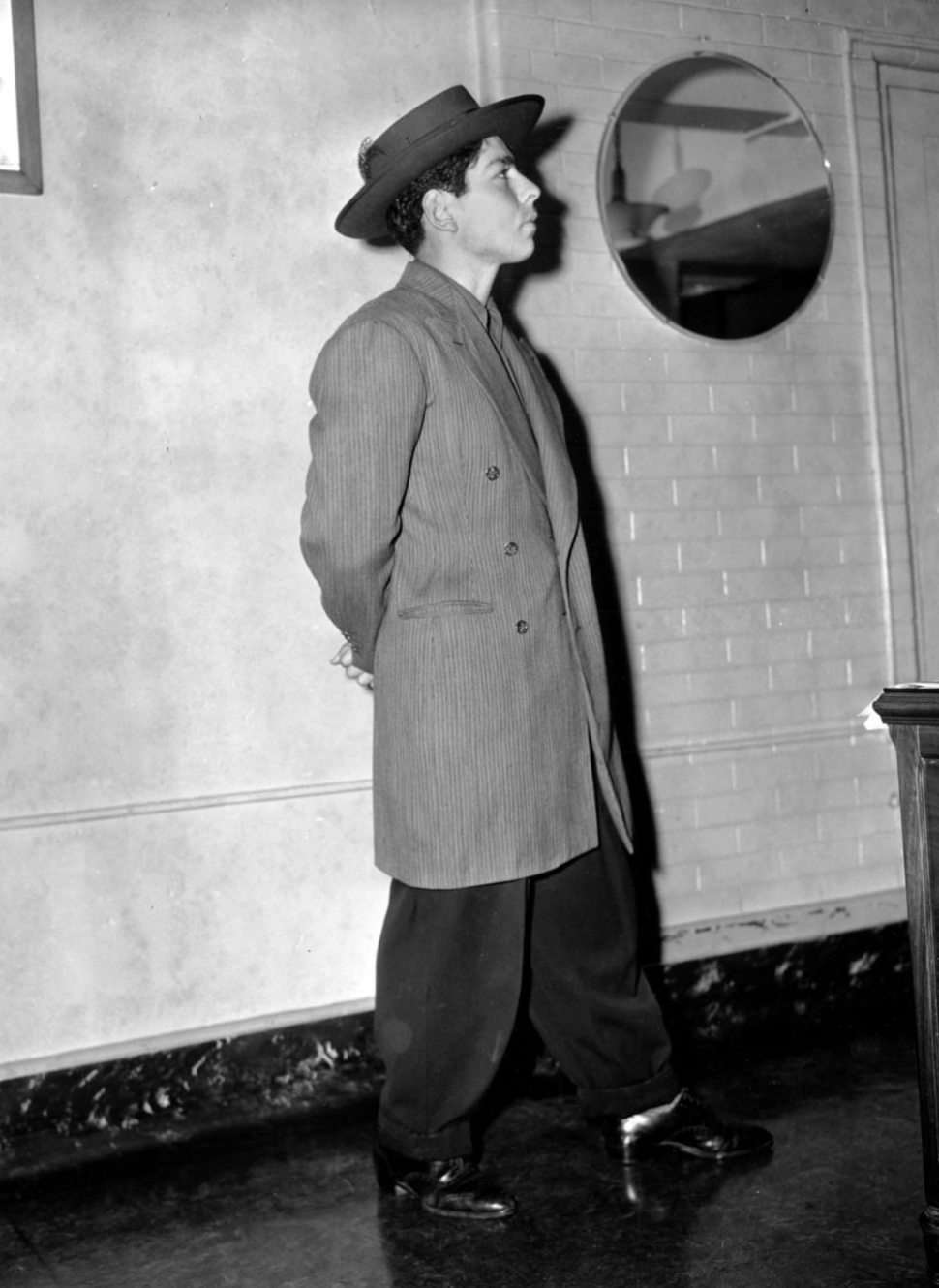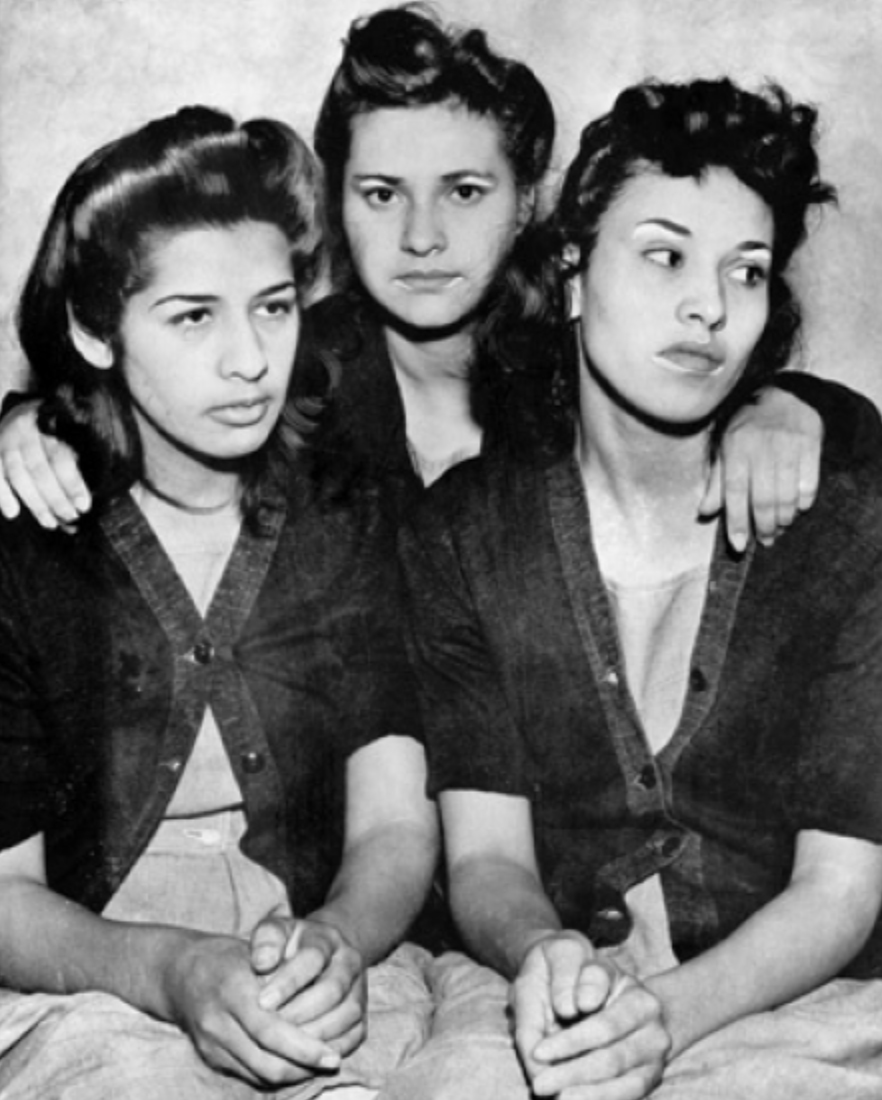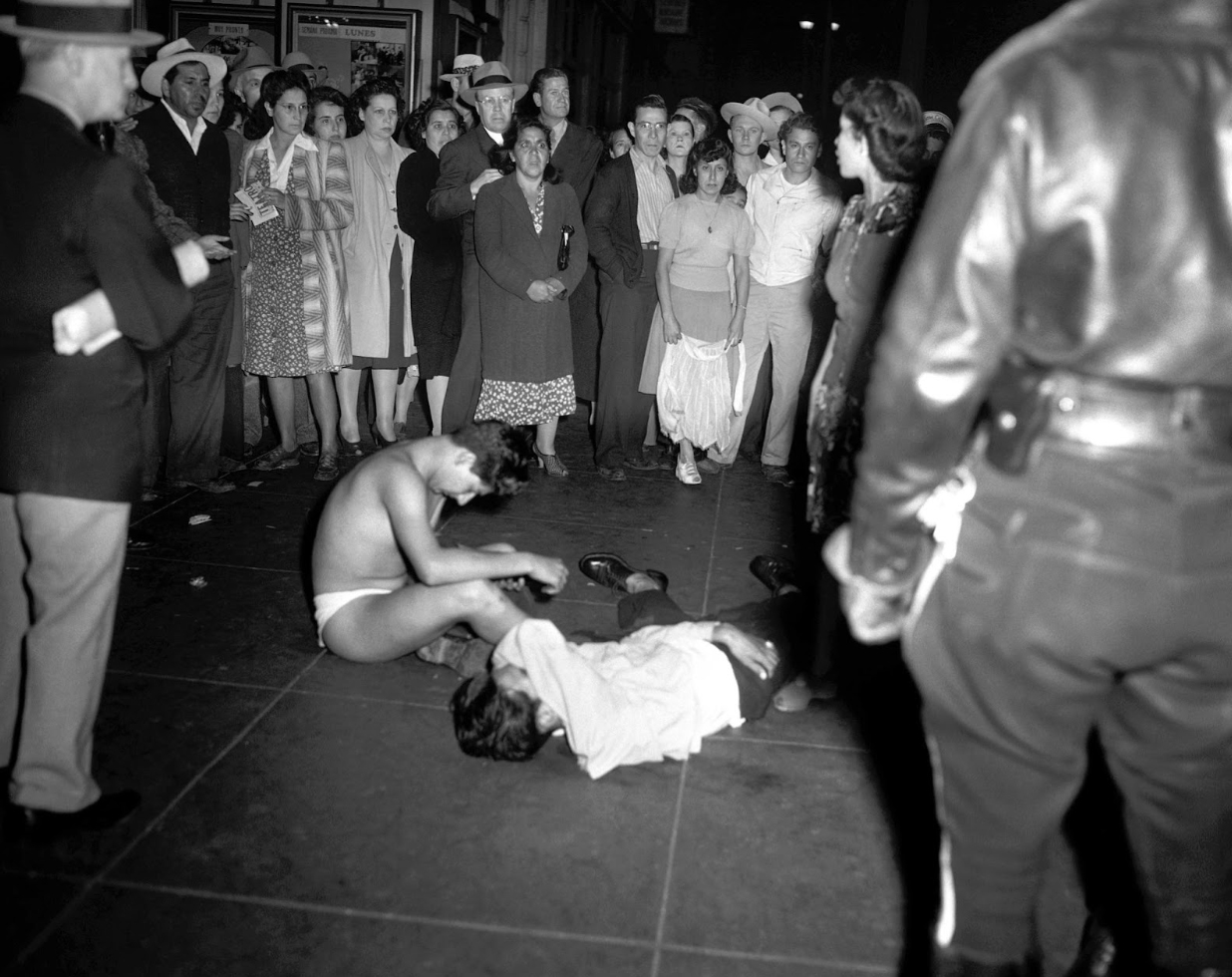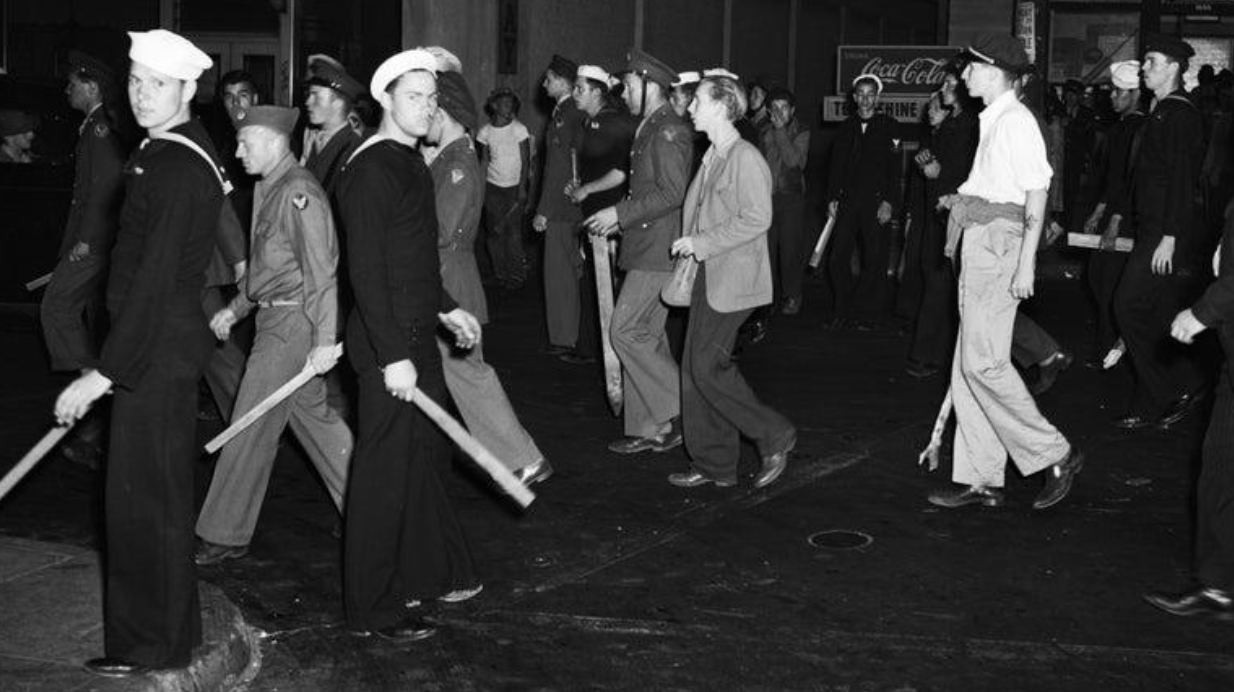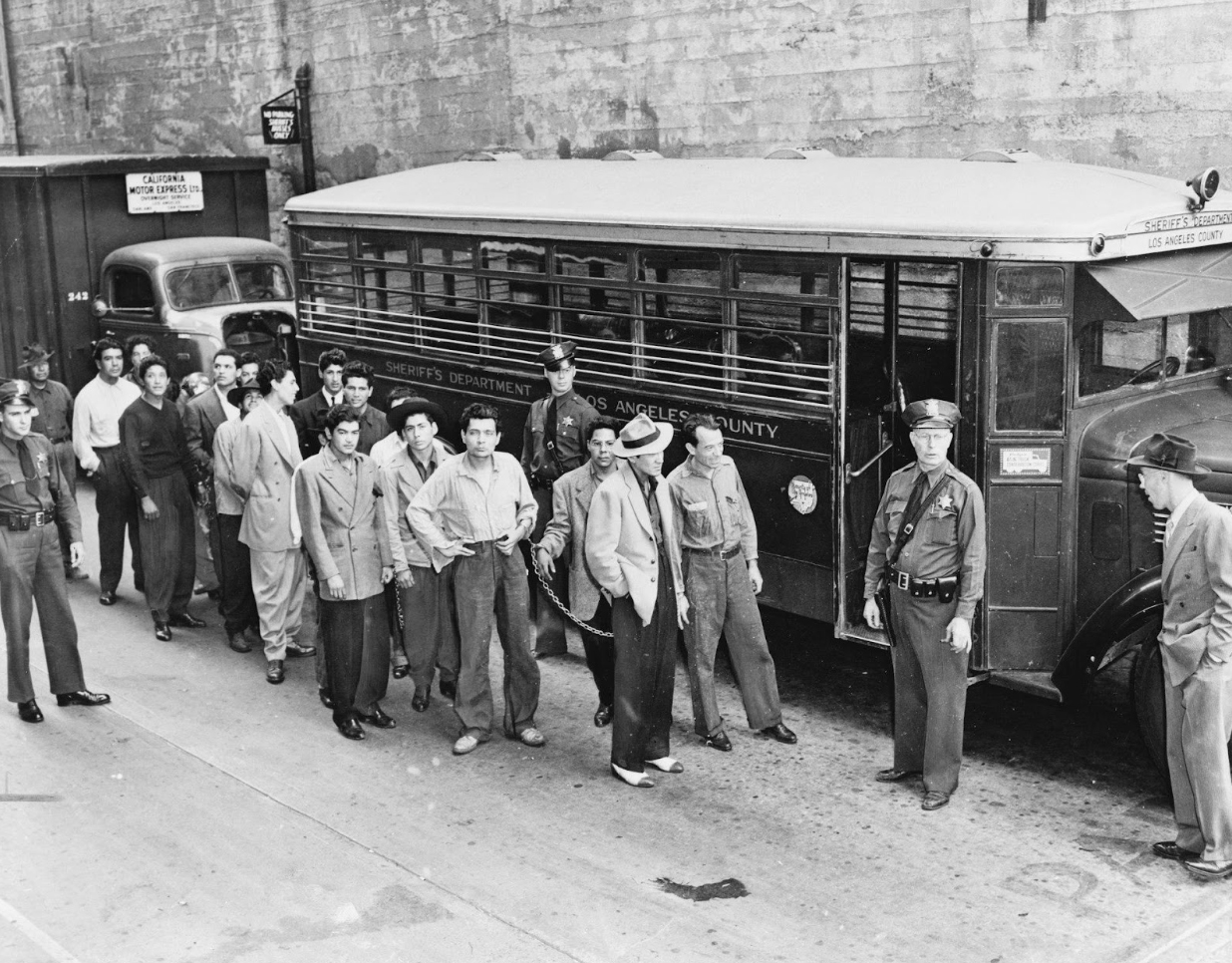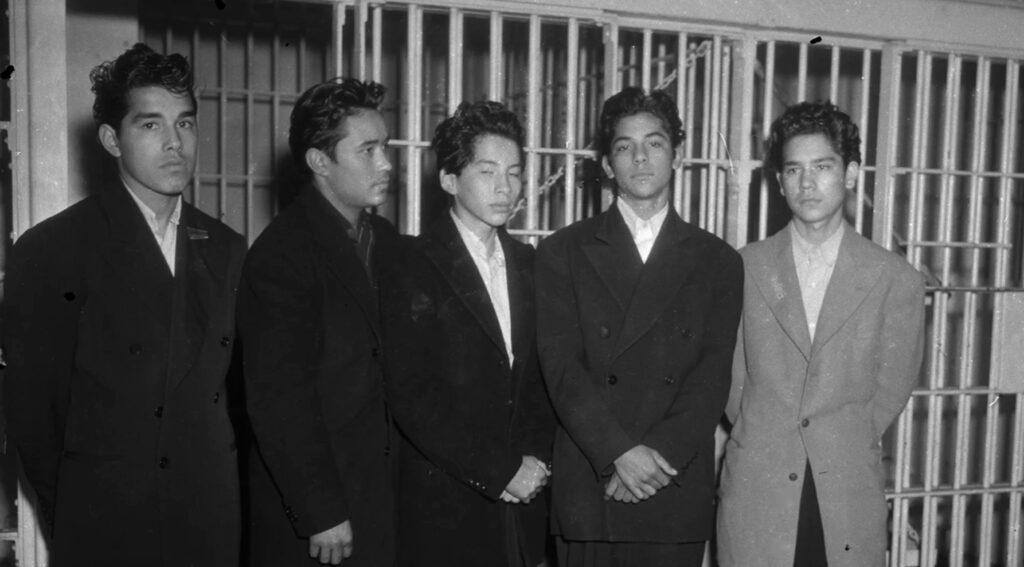
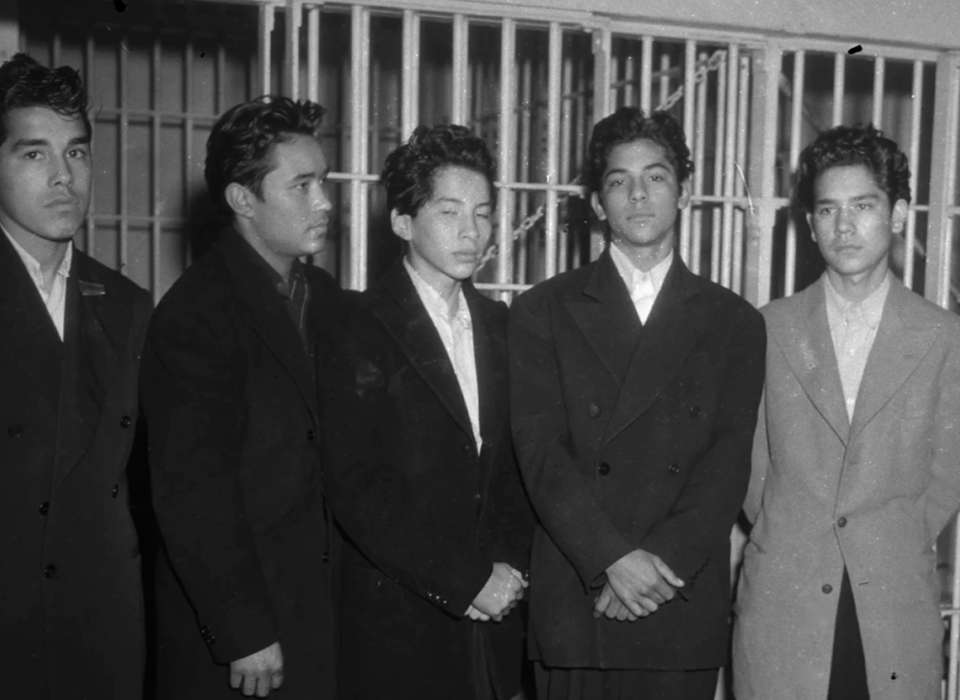
A group of Mexican American “zoot suiters” arrested during the Zoot Suit Riots, June 9, 1943. Courtesy of the Library of Congress.
On Monday, June 7, 1943, California-based journalist Carey McWilliams could only stand with the crowd gathered on Broadway in Los Angeles and watch the chaos unfold before his eyes.
“Thousands of Angelenos turned out for a mass lynching,” he reported. “A mob of several thousand soldiers, sailors, and civilians” stopped streetcars carrying patrons throughout the metro area, jerked “Mexicans, and some Filipinos and Negroes . . . out of their seats,” and beat them “with sadistic frenzy.” McWilliams was stunned as the mob continued moving through downtown Los Angeles and wreaking havoc, seemingly unstoppable. McWilliams soon learned that the attackers that night were looking for “every zoot-suiter they could find.”
Why was the zoot suit—high-waisted pants with baggy, pegged legs and a long coat with wide lapels—at the center of a wave of violence that gripped Los Angeles for five days in 1943? Popular among young Mexican American and Filipino American men in California during the early war years, the flamboyant zoot suit was more than a fashion statement. It was part of an identity that signaled a youthful masculinity and pride in belonging to a pachuco culture that embraced style and swagger—statements that challenged discriminatory “Juan Crow” laws and practices that often limited the rights of Mexican American men.
For the hundreds of predominantly Mexican American victims of what became known as the Zoot Suit Riots, a jacket and a pair of pants marked them as criminals for white servicemembers and civilians searching for someone to blame for the city’s inability to keep up with its growing population. The violence that beset Los Angeles was the product of rising racial tensions brought on by a variety of wartime factors across the United States in 1943.
Before it became a target for racial violence, the zoot suit was a new fashion that appealed to Black men in Harlem and was made popular by performers like Cab Calloway and Lionel Hampton. As historian Kathy Peiss notes, the zoot suit’s flowy fit looked good on the dancefloor, and the style quickly spread to other parts of New York City, becoming popular with Italian American and Jewish American men. Filipino American, Japanese American, and Mexican American men also adopted the trend when it spread to the West Coast, and even Mexican American women borrowed the zoot suit’s pants to create their own style. As with many fads, older generations didn’t quite understand the appeal but chalked its popularity up to youthful expression—even after the War Production Board banned the wearing and manufacturing of wasteful zoot suits intentionally cut with an excessive amount of rationed cloth.
Although zoot suits certainly earned the ire of those serious about rationing, they would soon become affiliated with crime and delinquency. Mexican emigrants populated Los Angeles during the early 20th century seeking job opportunities in the burgeoning urban area, while white migrants—many from the South and Midwest—also came to the West Coast at the height of the Great Depression. While Mexican Americans built a strong community in Los Angeles in the prewar years, they were consistently met with discrimination, including a program that forcibly removed even Mexican American citizens from California and deported them to Mexico in 1929.
More Mexicans arrived in Los Angeles at the beginning of World War II, along with Black and white defense workers and thousands of servicemembers. Sailors were stationed at the Naval Reserve Armory at Chavez near a predominantly Mexican American neighborhood. The city’s ballooning population led to shortages in housing and disrupted other services like transportation. As Los Angeles grew, so did racial and ethnic tensions. Young Mexican American men and women formed gangs for territorial control and protection including the 38th Street Gang. Members often embraced the pachuco style and, unfortunately, “zoot suit” and pachuco soon became shorthand for “gang.”
City officials and other residents of Los Angeles suspected that the activities of the 38th Street Gang were representative of all Mexican Americans. Later that year, the Los Angeles City Council added more fuel to the fire when it commissioned a special investigation into what it saw as a “Mexican American crime wave,” despite having little evidence of Mexican American culpability.
Prejudiced associations of the zoot suit with criminality were only reaffirmed on August 2, 1942, when José Gallardo Díaz, a 22-year-old agricultural worker, was found dead near the Sleepy Lagoon reservoir frequently used as a picnic spot by Mexican Americans. The official autopsy revealed that Diaz was intoxicated and the cause of death was blunt force trauma, but the Los Angeles Police Department asserted that Díaz was murdered by members of a rival gang. Officers arrested 24 members of the 38th Street Gang, 17 of whom were found guilty in January 1943 on charges of manslaughter and assault despite dubious evidence. (The convictions were later overturned in 1944 as the defendants’ constitutional rights to a fair trial had been violated.)
The Sleepy Lagoon case and the media’s emphasis on the incident as proof of a crime wave among Mexican Americans prompted a closer association between crime and those who wore the zoot suits. In the months that followed, brawls between sailors (who often assumed the zoot suiters were draft dodgers) and zoot suiters (some as young as 12 and 13 years old) occurred daily, according to Los Angeles police reports.
Simmering tensions hit a boiling point on May 31 near Chinatown in downtown Los Angeles when a scuffle broke out between 12 sailors and a group of Mexican American teenagers wearing zoot suits. No one knows exactly what prompted the fight, but Seaman Second Class Joe Dacy Coleman emerged with a broken jaw. When men back at the Naval Reserve Armory heard of Coleman’s injury, 50 sailors formed a vigilante group on June 3 and moved into downtown Los Angeles with concealed weapons in search of zoot suiters. Bands of servicemembers tore through the streets, finding any Mexican American wearing a zoot suit and viciously beating them after throwing them to the ground and tearing off their clothes.
“Searching parties of soldiers, sailors and Marines hunted them out and drove them into the open like bird dogs flushing quail,” author Seldon Cowles Menefee reported. “Zoot-suits smoldered in the ashes of street bonfires where they had been tossed by grimly methodical tank forces of service men.”
LAPD officers stood by as the assailants claimed they were acting in self-defense, instead arresting bloodied and bruised Mexican American men for “disturbing the peace.” Al Waxman, editor of East Los Angeles newspaper The Eastside Journal, was at the scene and pleaded with officers to step in, but they simply explained that it was “a matter for the military police” and refused to get involved.
The violence grew over the following two days as the mob swelled with civilians, sailors, soldiers, and Marines. Taxi drivers willingly drove sailors across the downtown area as they indiscriminately attacked any Mexican American they found, even if they were not wearing a zoot suit. Meanwhile, local and national newspapers praised the attackers, hailing them as protectors of the city against the dangerous zoot suiters. On June 4, the Oakland Tribune described the vigilante mob as a “vengeance squad” of volunteers gathered by the LAPD to “clean up” the crime caused by the pachucos in the city. The Bayonne Times reported on the “Gentlemen in Blue” as men who were merely responding to vicious attacks by the “zoot suit bums” on the wives of Navy men. “We are out to do what the police have failed to do—we’re going to clean up,” a petty Navy officer explained when interviewed.
On June 6 and 7, the mob met resistance when they moved into East Los Angeles and pushed into the predominantly Black neighborhood of Watts looking for zoot suiters. Rudy Leyvas, a teenager at the time of the riots, remembered setting traps with his friends: “Toward evening, we started hiding in alleys. Then we sent about 20 guys right out into the middle of the street as decoys. . . . They started coming after the decoys, then we came out. They were surprised. It was the first time anybody was organized to fight back.”
Parents feared for their children who might be attacked simply because they were young Mexican Americans. One mother pleaded with a police officer to leave her son alone. “Don’t take my boy, he did nothing. He’s only 15 years old! Don’t take him,” she cried, but the officer only hit her across the face with his nightstick. Another group of boys turned themselves in to police in a desperate attempt for protection. “Charge me with vagrancy or anything, but don’t send me out there!” one of them yelled as other children—most not wearing zoot suits—were beaten by a group of sailors.
Finally, on June 8, the riots subsided when military officials with the Southern Sector of the Western Defense Command declared Los Angeles off-limits to soldiers, sailors, and Marines and ordered military police to arrest disorderly servicemembers. The Los Angeles City Council also banned the wearing of zoot suits, a proclamation declared a victory by many residents. In the end, the LAPD arrested significantly more Mexican Americans (nearly 600) than servicemembers or other civilians.
Across the country, many offered explanations for the riots. Los Angeles Mayor Fletcher Brown blamed lawlessness and juvenile delinquency among Mexican American teenagers. Senator Jack Tenney of the California Senate Fact Finding Subcommittee on Un-American Activities suggested that the riots were the work of Communist agents and Axis spies stirring up racial trouble among Los Angeles’ Black and Mexican American communities. Some Mexican American leaders like Eduardo Queveda argued that the city needed a police force that was more prompt and equitable to address issues when they arose rather than waiting until they came to a head.
Still, others insisted that there was a simpler explanation: racism. In the days following the riots and after the Mexican Embassy wrote to the State Department demanding an explanation for the violence directed toward Mexican Americans, California Governor Earl Warren appointed a special commission to investigate the zoot suit riots. The report highlighted the lack of resources available to Mexican Americans that contributed to unrest, but ultimately concluded that “it is significant that most of the persons mistreated during the recent incidents in Los Angeles were either persons of Mexican descent or Negroes. In undertaking to deal with the cause of these outbreaks, the existence of race prejudice cannot be ignored.” During a June 16, 1943, press conference on the riots, First Lady Eleanor Roosevelt echoed the same sentiment, stating that “race problems” were growing in the United States and that “we must just begin to face it.” Senator Tenney responded by calling her a Communist.
Like the commission and Roosevelt, George I. Sanchez, an educator and civil rights activist, stressed the deep underlying issues behind the riots in his 1943 article “Pachucos in the Making.” While there were certainly young Mexican Americans who were engaged in criminal activities, he argued, “the seed for the pachucos was sown a decade or more ago by unintelligent educational measures, by discriminatory social and economic practices, by provincial smugness and self-assigned ‘racial’ superiority.”
Similarly, the Omaha Guide, a Black newspaper in Nebraska, noted that the “outburst against zoot suiters which has been shown to be directed exclusively against persons with dark skin” was merely one instance in a “tragic growth of mob violence that threatens to become nationwide . . . and seriously hamper successful prosecution of the war” unless something was done by the federal government. The author recommended an anti-lynching bill that would make racially motivated murder a federal crime but also warned: “We cannot readily throw our full resources into the fight against the enemies of democracy abroad if internal strife is constantly provoked by native fascists.” The servicemembers’ indiscriminate attacks on Mexican Americans made the Zoot Suit Riots part of a larger pattern of racial unrest in Detroit; Harlem; Beaumont, Texas; and Mobile, Alabama, that revealed internal social and political strains in the United States during the war.
On May 16, 2023, the Los Angeles County Board of Supervisors officially condemned the Zoot Suit Riots. Supervisor Hilda Solis declared the wartime violence “a dark chapter in Los Angeles County’s history,” but it is also a moment in America’s history that highlights the struggle of fighting racism on the Home Front during World War II.
